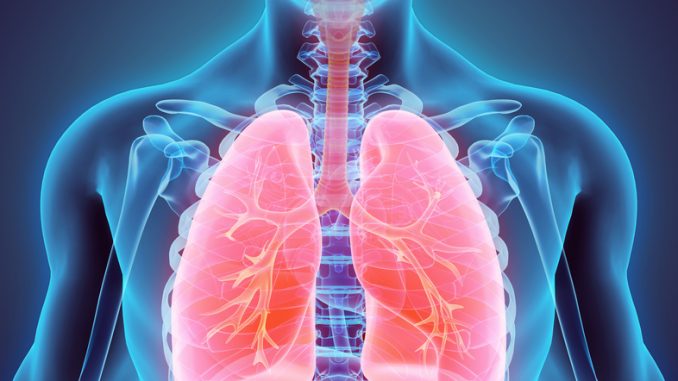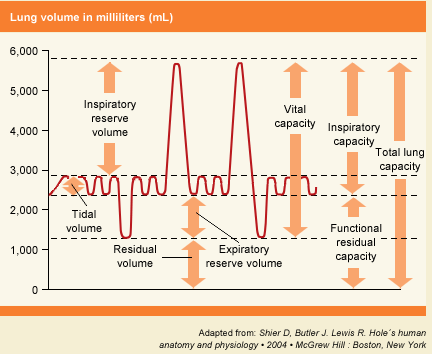
- The quantities of air the lungs received, held or expeled under different conditions are called pulmonary or lung volumes.
- Pulmonary capacity refers to a combination of two or more pulmonary volumes.
- Tidal volume(TV):
- It is the volume of air normally inspired or expired in one breath without any effort.
- For a healthy adult human male, it is about 500 ml.
- Actually, only 350 ml of air enters the lung alveoli for the exchange of gases, the remaining 150 ml fills the respiratory passage.
- The latter (150 ml) is often called dead air space because no exchange of gases takes place here.
- Thus, tidal volume(500 ml)= alveolar volume (350 ml) + dead air space (150 ml)
- During excitement and activity, the tidal volume increases by 4 to 10 times.
- Inspiratory reserve volume (IRV):
- It is the extra amount of air which can be inhaled forcibly after a normal inspiration.
- It is about 2000 to 2500 ml.
- Expiratory reserve volume (ERV):
- It is the extra amount of air which can be exhaled forcibly after a normal expiration.
- It is about 1000 to 1500 ml.
- Vital capacity (VC) of lungs:
- It is the amount of air which can be inhaled and also exhaled with maximum effort.
- It is about 5 to 4.5 liters in a normal adult person.
- It is equal to the sum of the tidal, inspiratory and expiratory reserve volumes (500+2000+1500=4000 ml)
- Vital capacity represents the maximum amount of air one can renew in the respiratory system in a single respiration.
- It is higher in athletes and sportsmen than in others, in mountain dwellers than in plain dwellers, in males than in females, and in the young than in the old persons.
- Smoking reduces the vital capacity of the lungs and decreases the capacity for strenuous muscular activity.

- Residual volume (RV):
- Some air always remains in the lungs even after forcible expiration; this amount of air is called residual volume.
- It is about 1500 ml.
- The residual air enables the lungs to continue exchange of gases even after maximum exhalation or on holding the breath.
- In other words, exchange of gases goes on in the lungs uninterrupted during inspiration as well as expiration.
- Inspiratory capacity (IC):
- It is the total volume of air which can be inhaled after a normal expiration.
- It is equal to the tidal volume plus the inspiratory reserve volume, i. e. IC= TV + IRV
- It is about 2500 to 3000 ml.
- Functional residual capacity (FRC):
- It is the sum of residual volume and the expiratory reserve volume, i. e. FRC= RV + ERV
- It is about 2500 to 3000 ml.
- Total lung capacity (TLC):
- It is the sum of the vital capacity and the residual volume.
- It is about 5000 to 6000 ml.
* Respiratory quotient (RQ):
- The ratio of the volume of CO2 produced to the volume of O2 used in unit time is called respiratory quotient (RQ).
- It varies with different foods utilized in respiration. For glucose, RQ is 1 (RQ=6CO2/6O2= 1), for fats about 0.7, for proteins about 0.85.
- The RQ indicates the type of food oxidized in the animal body during respiration.